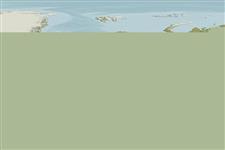Classification / Names
Nomi Comuni | Sinonimi | Catalog of Fishes(Genere, Specie) | ITIS | CoL | WoRMS | Cloffa
>
Ophidiiformes (Cusk eels) >
Ophidiidae (Cusk-eels) > Ophidiinae
Etymology: Ophidion: Diminutive of Greek, ophis = serpent (Ref. 45335); saldanhai: Named in honor of the Portuguese ichthyologist Luis Saldanha (Ref. 34017).
Environment: milieu / climate zone / depth range / distribution range
Ecologia
marino demersale; distribuzione batimetrica 31 - 37 m (Ref. 34017). Tropical
Eastern Central Atlantic: known only from Cape Verde and the Gulf of Guinea.
Size / Peso / Age
Maturity: Lm ? range ? - ? cm
Max length : 15.0 cm SL maschio/sesso non determinato; (Ref. 34017)
Short description
Morfologia | Morfometria
Spine dorsali (totale): 0; Raggi dorsali molli (totale): 117; Spine anali 0; Raggi anali molli: 105 - 106. Color of fresh holotype: Pale pink, with a silver to golden stripe all along middle body, and a more silvery area a the preopercular region, behind and under the eye. The dorsal portion of the head (snout and nape) and of the body was slightly darker. Belly pigmentation whitish. The margins of the dorsal and anal fins were edged in white; blackish subterminal stripe, darker at the rear of the fins. Black pupil and iris reddish to silvery, with a black blotch at the dorsal portion (Ref. 34017).
Reproductive strategy possibly similar to other members of this family featuring oviparity, with oval pelagic eggs floating in a gelatinous mass (Ref. 205).
Life cycle and mating behavior
Maturità | Riproduzione | Deposizione | Uova | Fecundity | Larve
Matallanas, J. and A. Brito, 1999. Description of Ophidion saldanhai sp. nov. from the Cabo Verde Islands. J. Fish Biol. 55(5):931-936. (Ref. 34017)
IUCN Red List Status (Ref. 130435)
Threat to humans
Harmless
Human uses
Informazioni ulteriori
Nomi ComuniSinonimiMetabolismoPredatoriEcotossicologiaRiproduzioneMaturitàDeposizioneSpawning aggregationFecundityUovaEgg development
Age/SizeAccrescimentoLength-weightLength-lengthLength-frequenciesMorfometriaMorfologiaLarveDinamica popolazioni larvaliReclutamentoAbbondanzaBRUVS
BibliografiaAcquacolturaProfilo di acquacolturaVarietàGeneticaElectrophoresesEreditarietàMalattieElaborazioneNutrientsMass conversion
CollaboratoriImmaginiStamps, Coins Misc.SuoniCiguateraVelocitàModalità di nuotoArea branchialeOtolithsCervelliVista
Strumenti
Special reports
Download XML
Fonti Internet
Estimates based on models
Preferred temperature (Ref.
123201): 16.6 - 27, mean 19.5 °C (based on 25 cells).
Phylogenetic diversity index (Ref.
82804): PD
50 = 0.5000 [Uniqueness, from 0.5 = low to 2.0 = high].
Bayesian length-weight: a=0.00102 (0.00046 - 0.00225), b=3.06 (2.88 - 3.24), in cm total length, based on all LWR estimates for this body shape (Ref.
93245).
Trophic level (Ref.
69278): 3.5 ±0.7 se; based on size and trophs of closest relatives
Resilienza (Ref.
120179): Alto, tempo minimo di raddoppiamento della popolazione meno di 15 mesi (Preliminary K or Fecundity.).
Fishing Vulnerability (Ref.
59153): Low vulnerability (10 of 100).
